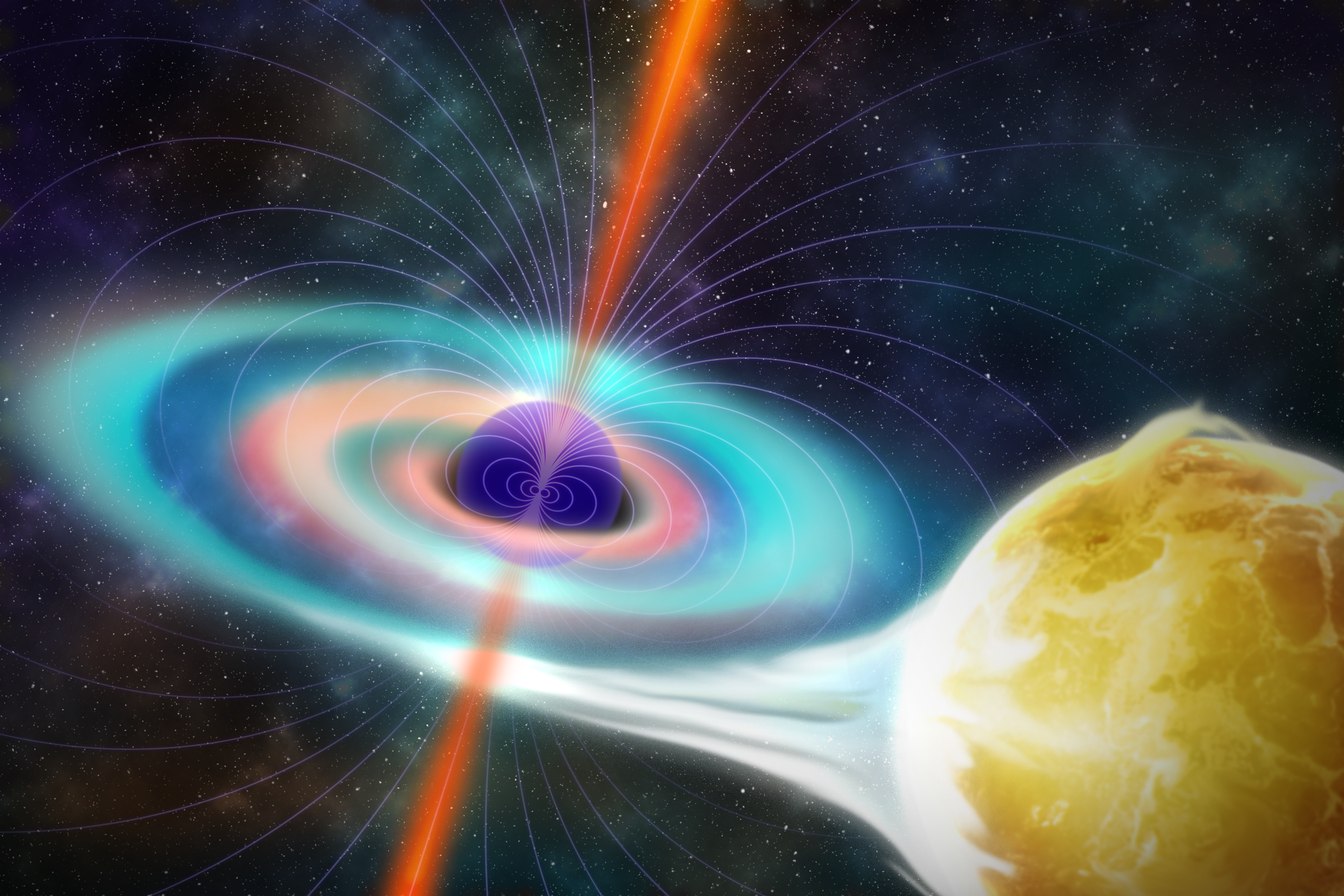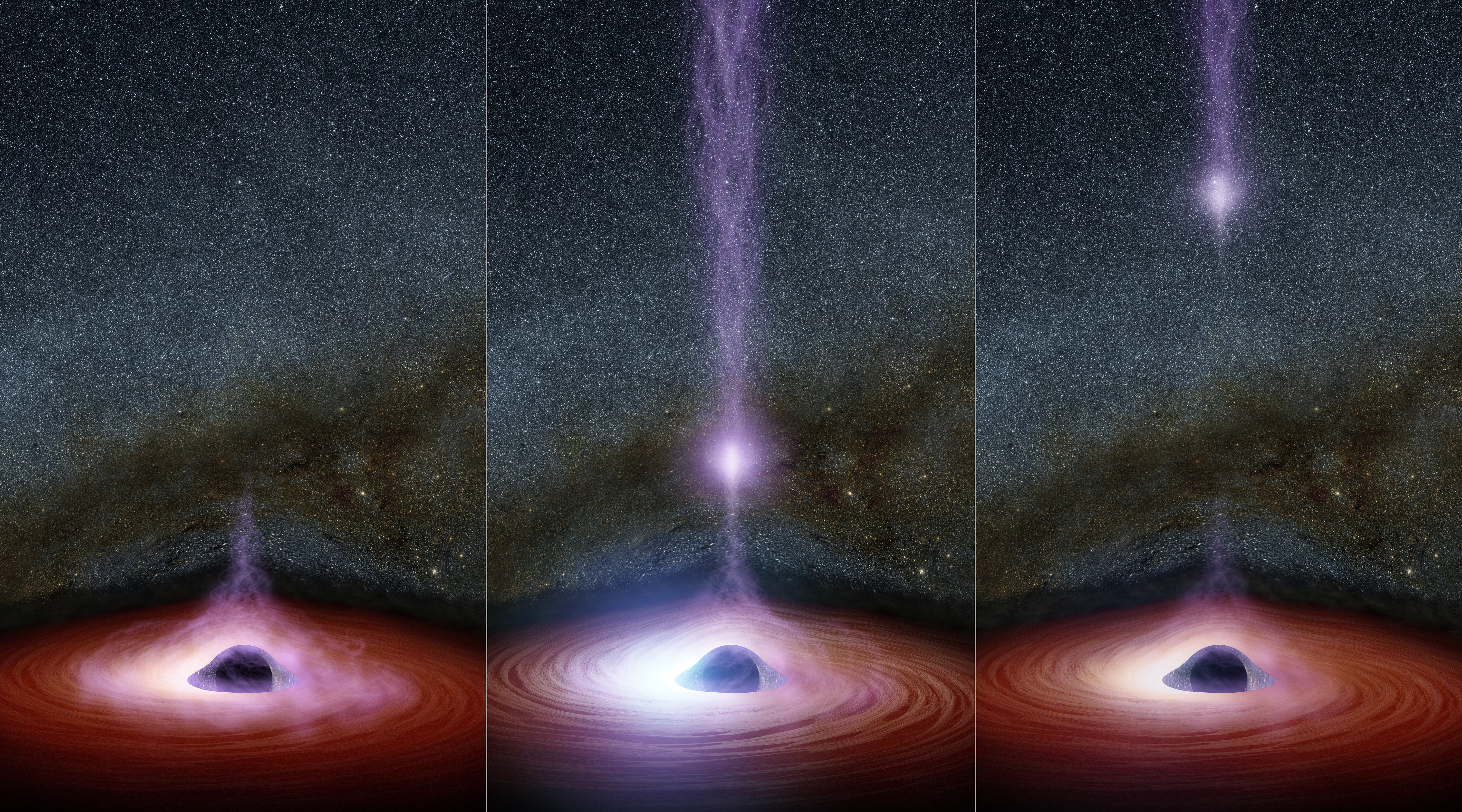Massive Black Hole Has Surprisingly Weak Magnetic Field

The region around a black hole is a playground of immense forces and energies. Now, astronomers have measured the magnetic field surrounding a black hole located roughly 8,000 light-years away, and found it was thousands of times weaker than they had thought it would be. The results confirmed decades-old models of black holes and revealed new puzzles in need of explanation.
The black hole V404 Cygni is relatively small, only 10 times the mass of our sun. Black holes can reach millions or billions of solar masses. The object is also located relatively close to Earth. "If you think of the galaxy as a metropolitan area, it's not in our neighborhood, but it's in our suburb," University of Florida astronomer Steve Eikenberry, who led the study with his doctoral student Yigit Dallilar, told Space.com. The team of scientists discovered that the magnetic field surrounding V404 Cygni measures only 500 gauss. They were expecting field strengths four orders of magnitude larger. For reference, the Earth's magnetic field is around 0.5 gauss, and a typical refrigerator magnet ranges from 50 to 100 gauss. The research is detailed in the journal Science today (Dec. 7).
V404 Cygni is siphoning material from a companion star that is slightly smaller than Earth's sun. The material forms what scientists call an accretion disk, which rotates around the black hole at high speeds and temperatures of millions of degrees. At these energies, the atoms lose their electrons and form a vortex of charged particles, a dynamo that generates strong magnetic fields. [Related: Magnetic Fields Nudge Matter into Black Holes]
Similar to the processes at work in our sun, this magnetic field supercharges particles in the wispy corona that surrounds the black hole. This essentially turns the system into a cosmic particle accelerator, whipping particles in the corona to relativistic energies, Eikenberry said. These are speeds so fast that mass and energy begin blurring. The corona serves as the base for huge jets of matterthat shoot away along the black hole's axis of rotation.
"We think that it's all really part and parcel of the same phenomenon — that a magnetized corona, we think, is necessary to make a jet," Eikenberry said.
Predicting a black hole outburst
In 1989, V404 Cygni erupted with X-ray activity for several weeks, leading to a flurry of research. Chris Done, at Durham University in England, came up with a model of the system that predicted the black hole would flare again in 25 to 30 years. This would happen when built-up material in the outer part of the accretion disk flooded inward, her model said. And in June 2015, she was proven right.
"She did a very rare thing for theorists and actually made a prediction, and it came true," said Eikenberry.
Get the Space.com Newsletter
Breaking space news, the latest updates on rocket launches, skywatching events and more!
Based on Done's predictions, scientists were ready when V404 Cygni reawakened. They aimed a litany of instruments toward the black hole, including NASA's NuSTAR space telescope, the William Herschel Telescope and the 34-foot Gran Telescopio Canarias in the Canary Islands, using the Canarias InfraRed Camera Experiment, which was designed and built by the university's graduate students and postdocs.

On June 25, about one day into the two-week event, the process energizing the corona abruptly stopped for a few minutes, and the particles in the corona began to lose energy. Dallilar noted to Eikenberry that the light emissions were fading at the same rate they would in a powered-down particle accelerator here on Earth. Namely, higher-energy particles lost their energy more quickly, doing so by emitting higher-energy light, Eikenberry said.
A synchrotron in space?
Inside scientists' largest particle accelerators, called synchrotrons, a strong magnetic field keeps charged particles whizzing around the circular machines. The strength of this field determines how quickly the particles radiate energy. So, when V404 Cygni suddenly quieted down, Eikenberry and Dallilar used these same equations to determine the black hole's magnetic field. They used the time it took for light in different parts of the spectrum to fade away to calculate the strength of the black holes' magnetic field. The precision was astounding, the researchers said.
"Over a factor of 100,000 in energy, and [across] five different bands, [the measurements] give you exactly the same number every time," Eikenberry said. "I've never seen anything that clean in my life." [Black Hole Quiz: Test Your Space Knowledge]

Ultimately, this finding confirms that the model scientists have used for decades is accurate, Eikenberry said. The accretion disk and corona function as a synchrotron, with the disk energizing the corona. And this all contributes to the formation of jets.
But scientists still don't understand the exact mechanism by which this happens, Eikenberry said. What's more, he and Dallilar discovered that V404 Cygni's magnetic field measures a mere 500 gauss overall. "Most of the theories that I know of invoke magnetic fields of a million gauss, or 10 million or 100 million gauss," Eikenberry said.
The energy of a black hole's jet is proportional to its magnetic field squared, so even a small error in the strength of the field would lead to a huge discrepancy between the power scientists observe in the jets and the numbers they calculate, Eikenberry said. He added that he speculates something is amplifying the corona's magnetic field in the center, right at the base of the jets, raising it to the strengths that scientists expect are required for the jets to launch.
"That's exactly what we're in the middle of [testing] right now," said Eikenberry. "Stay tuned to that in another six months."
Email Harrison Tasoff at htasoff@space.com or follow him @harrisontasoff. Follow us @Spacedotcom, Facebook and Google+. Original article on Space.com.
Join our Space Forums to keep talking space on the latest missions, night sky and more! And if you have a news tip, correction or comment, let us know at: community@space.com.

Harrison Tasoff is a science journalist originally from Los Angeles. He graduated from NYU’s Science, Health, and Environmental Reporting Program after earning his B.A. in mathematics at Swarthmore College. Harrison covers an array of subjects, but often finds himself drawn to physics, ecology, and earth science stories. In his spare time, he enjoys tidepooling, mineral collecting, and tending native plants.









